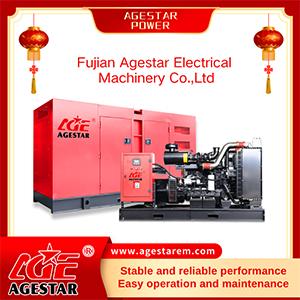Causes and treatment of motor heating
n the process of using the motor, heating and scalding is a very common phenomenon, and the reasons for this phenomenon may be various. This paper summarizes some common reasons, hoping to provide some reference and help in the process of using the motor.
1. Abnormal operation of bearing
Whether the bearing works normally can be judged by hearing and temperature experience. Use hand or thermometer to detect the bearing end to judge whether its temperature is within the normal range; You can also use a listening stick (copper rod) to contact the bearing box. If you hear the impact sound, it means that one or several balls may be crushed. If you hear the hissing sound, it means that the lubricating oil of the bearing is insufficient. The motor should be changed once after running for 3000 ~ 5000 hours.
2. The power supply voltage is high, and the excitation current increases
Too high voltage will endanger the insulation of the motor and cause it to be broken down. When the power supply voltage is too low, the electromagnetic torque will be reduced. If the load torque is not reduced and the rotor speed is too low, the increase of slip will cause the motor overload and heating, and the long-term overload will affect the service life of the motor. When the three-phase voltage is asymmetric, that is, when the voltage of one phase is high or low, it will lead to excessive current of a phase, motor heating, and the reduction of torque will send out "buzzing" sound, which will damage the winding for a long time.
In short, whether the voltage is too high, too low or asymmetric, the current will increase, and the motor will be heated and damaged. Therefore, according to national standards, the change of motor power supply voltage should not exceed ± 5% of the rated value, and the motor output power can maintain the rated value. The power supply voltage of the motor shall not exceed ± 10% of the rated value, and the difference between the three-phase power supply voltages shall not exceed ± 5% of the rated value.
3. Abnormal vibration or noise of motor
This situation belongs to the vibration caused by the motor itself. Most of it is caused by poor dynamic balance of the rotor, poor bearings, bending of the rotating shaft, different shaft centers of the end cover, base and rotor, loose fasteners or uneven installation foundation of the motor, and improper installation. It may also be transmitted from the mechanical end, which should be eliminated according to the specific situation.
4. Motor phase failure
Almost half of the motor burnout is caused by the lack of phase operation of the motor. The lack of phase often causes the motor to fail to run or rotate slowly after starting, or the rotation is weak, and the current increases with a "buzzing" sound. The main reasons for phase failure operation are as follows:
If one phase of the power supply line is cut off due to the failure of other equipment, other three-phase equipment connected to the line will run without phase.
One phase of the circuit breaker or contactor is out of phase due to burning of the bias voltage or poor contact.
Phase loss of motor incoming line due to aging, wear and other reasons.
One phase winding of the motor is open circuit, or one phase connector in the junction box is loose.
5. Materials leak into the motor
Solid materials or dust entering the motor from the junction box will reach the air gap between the stator and rotor of the motor, causing the motor to sweep the bore until the insulation of the motor winding is worn out, causing the motor to be damaged or scrapped. If liquid and gas media leak into the motor, it will directly cause the motor insulation to drop and trip. General liquid and gas leakage has the following forms:
Leakage of various containers and transmission pipelines, sealing leakage of pump body, flushing equipment and ground;
After the mechanical oil leaks, it enters the motor from the gap of the front bearing box;
The oil seal of the reducer connected to the motor is worn, and the mechanical lubricating oil enters along the motor shaft. After it accumulates inside the motor, the motor insulating paint is dissolved, so that the insulation performance of the motor is gradually reduced.
6. Winding short circuit, turn to turn short circuit, phase to phase short circuit and winding open circuit
After the insulation between two adjacent conductors in the winding is damaged, the two conductors collide, which is called winding short circuit. The winding short circuit in the same winding is called interturn short circuit. The winding short circuit between two-phase windings is called phase to phase short circuit. Either way, it will increase the current of one or two phases, cause local heating, aging insulation and damage the motor. Winding open circuit refers to the fault caused by the stator or rotor winding of the motor breaking or burning. Whether the winding is short circuited or open circuited, it may cause the motor to heat up or even burn out. Therefore, the machine must be shut down immediately after this happens.
7. Other non mechanical and electrical fault causes
Motor temperature rise caused by other non mechanical and electrical faults may also lead to motor failure in serious cases. If the ambient temperature is high, the motor lacks a fan, the fan is incomplete, or the fan cover is missing. In this case, forced cooling is necessary to ensure ventilation or replace the fan blades, otherwise the normal operation of the motor cannot be guaranteed.
In order to adopt correct methods to deal with motor faults, we must be familiar with the characteristics and causes of common motor faults, grasp the key factors, and conduct regular inspection and maintenance, so as to avoid detours, save time, eliminate faults as soon as possible, and keep the motor in normal operation. So as to ensure the normal production of the workshop.





